7/31/2025
Modernizing the Classics
Story & Photos by Chris Beytes, Bill Calkins & Jennifer Zurko

 Phlox Candy Cloud (Darwin Perennials)
Phlox Candy Cloud (Darwin Perennials)
Candy Cloud is a P. subulata bred to be significantly later than standard P. subulate, blooming between mid-April and mid-May—“bridging the gap” between regular P. subulata and the main-season spring annuals and perennials, as they said. And as a bonus, Candy Cloud blooms for six to eight weeks (depending on temperature, of course). The collection has four colors: Dark Pink, Pink, Lavender and Blue. Oh, we should mention that it requires a summer bulking and winter vernalization—it is not a first-year flowering variety. Zone 4.
Erysimum Brightside (Darwin Perennials)
The new Brightside series of Erysimum from Darwin launched with five colors—Bright Yellow, Lemon Ice, Lilac Breeze, Yellow and White. It’s a perennial in the south (Zone 7 hardy) and will make a nice container plant in colder climates. A major pollinator attractor, Brightside will grow about 18 to 22 inches tall and wide and is an excellent early-spring season extender.
 Geranium Purple Glow (Darwin Perennials)
Geranium Purple Glow (Darwin Perennials)
Hardy to Zone 3a, new Purple Glow perennial geranium has major flower power with vivid purple tones and will over a lot of ground in beds or fill containers well. Perennial geraniums are fairly deer resistant and tough once established. Expect Purple Glow to spread about 14 inches and stay low and mounding.
 Penstemon Mountain Treats (Darwin Perennials)
Penstemon Mountain Treats (Darwin Perennials)
This series comes from interspecific breeding and features more medium-vigor, launching with five colors—Rose, Light Pink, Lavender, Red and Fuchsia. The features include strong basal branching, high flower count and excellent environmental tolerance (they were bred in Pennsylvania). Zone 6.
 Penstemon Summit Sweets (Darwin Perennials)
Penstemon Summit Sweets (Darwin Perennials)
They’re tall (2.5 to 3 ft.) with blooms all the way to the top of the plant. Two colors are available for 2026—Purple and Ruby—with more to come, we’re sure. Zone 5.
 Grasses From Benary
Grasses From Benary
Benary’s lineup now includes a few grassy plants, which they’ve never had before. JenZ loved a lagurus called Bunny, with fuzzy plumes that can be used as a component plant or dried and popped in vases (Zone 4). We also liked Bluey and Spiky—koleria (Zone 5) and corynephorus (Zone 4) grasses, respectively. Both of those will grow 2 ft. by 2 ft. in the landscape. Lastly, another component plant, although it works well as a standalone in fall programs, is ornamental millet, and Benary selected a nice one with super-dark plumes and green-to-bronze foliage, naming it Inky (Zone 6).
 Veronica Skyward Light Pink (Darwin Perennials)
Veronica Skyward Light Pink (Darwin Perennials)
A first-year flowering perennial that thrives in full sun, the Skyward series now has four colors. It’s good for Zones 4b to 9a.
 Coreopsis Sunfetti Yellow Bicolor (Darwin Perennials)
Coreopsis Sunfetti Yellow Bicolor (Darwin Perennials)
A standalone variety with a pretty mounding habit and good powdery mildew resistance, they say. Zone 5.
 Gaillardia Guapa (Darwin Perennials)
Gaillardia Guapa (Darwin Perennials)
Gaillardia Guapa Flamenco Bicolor and Guapa Red are good for Zones 5a to 9b. “Guapa” means handsome (in the feminine sense) in Spanish.

 Rudbeckia Suntacular (Darwin Perennials)
Rudbeckia Suntacular (Darwin Perennials)
Rudbeckia Suntacular gets loads and loads of yellow flowers (even though it was only showing a few in the trial). It’s hardy from Zones 5a to 8b.
Dianthus From Hem Genetics
Dutch breeder Hem is known for breeding naturally compact seed annuals and perennials. This year, they were touting dianthus. Divinity is a new D. chinensis series that has that no-PGR-needed compactness they’re known for. It’s like their Diana series, but more compact. Divinity offers seven colors. And Dianthus Supra is an existing perennial (Zone 6) interspecific dianthus series that gets some new Picotee colors: Pink Picotee, Scarlet Picotee and Cherry Picotee.
 Lavender Voltage Violet (PP&L)
Lavender Voltage Violet (PP&L)
Voltage Violet, an L. stoechas type (Spanish) with gray foliage and dusky violet flowers, is not quite as vivid in color as the varieties flanking it, but they explained that the variety more than makes up for it in its toughness in the landscape. Hardy in Zones 7 to 9.
 Euphorbia Miner’s Berry Bourdeaux (PP&L)
Euphorbia Miner’s Berry Bourdeaux (PP&L)
This euphorbia has deep red foliage that goes almost black in the summer, then rosy-pink in the fall. It’s very hardy (Zones 4 to 8).
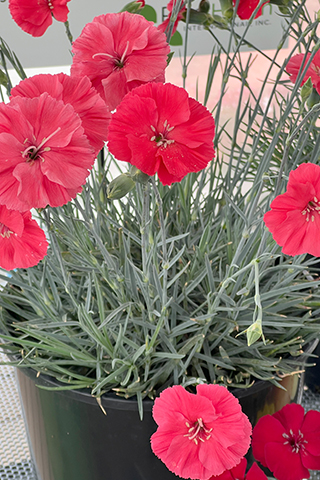
 Dianthus From PlantHaven
Dianthus From PlantHaven
PlantHaven’s new dianthus, which comes from well-known breeder Pinks by Whetman, includes Orange Meringue, which is part of their single-flowered American Pie collection; while Lemon Sparkler and Orange Sparkler are part of the double-flowered Scent First collection. They’re all Zone-5 hardy, colorful and the doubles are nicely fragrant.
Euphorbia Tiny Treasure (PlantHaven)
This Sahara Euphorbia called Tiny Treasure has “fresh, zesty” chartreuse foliage, as they put it. This “spurge,” as it’s known, is Zone-6 tolerant ... probably even Zone 5, they say. And it’s tough and drought tolerant, too.
 Lavender LaDiva (Dümmen Orange)
Lavender LaDiva (Dümmen Orange)
Dümmen’s lavenders are impressive—we don’t know if you can find lavender plants with showier spikes and bracts (the two parts of the flowers that provide all the color) than theirs. Among the introductions, the most-showy award goes to their Spanish (L. stoechas) La Diva collection, which gets two additions: La Diva Berry Rosey (rose-pink) and Berry Bountiful (purple), shown flanking the existing Berry Beautiful. They look good in pots or baskets. Zone 4.
 Viola Spring Morning (Dümmen Orange)
Viola Spring Morning (Dümmen Orange)
Dümmen introduced their first violas for 2026—a seven-color series called Spring Morning. As a Zone-5 perennial, these violas will bloom in spring and then come back into flower for fall. They’ve shown good heat and humidity tolerance in trials and include more than just blue tones, with plenty of yellow, white and dark purple tones. The color range is more similar to annual pansies than traditional perennial violas.
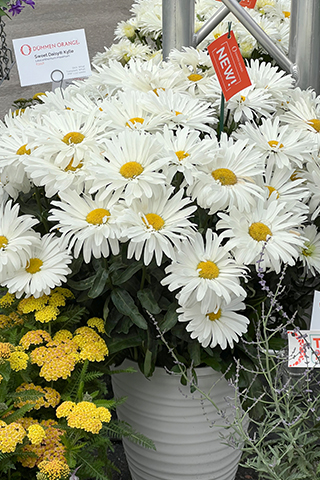
 Leucanthemum Sweet Daisy Kylie (Dümmen Orange)
Leucanthemum Sweet Daisy Kylie (Dümmen Orange)
A daisy with massive white flowers, the species name is L. maximum, which was new to us, but certainly described the palm-sized blooms. Zone 5.
Campanula Ultra Violet (Dümmen Orange)
This variety would make a great rock garden or alpine plant with vibrant purple flowers. Campanula is a new genus to Dümmen, but not the only new one in the trial. Zone 4.
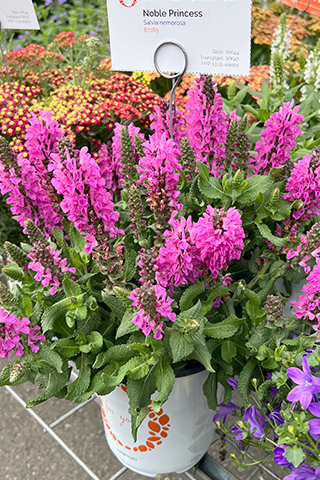
 Salvia Noble Princess (Dümmen Orange)
Salvia Noble Princess (Dümmen Orange)
Dümmen Orange’s Salvia nemarosa Noble Knight gets a bright pink sister, Noble Princess. She is just a tad later than her brother. Zone 3.
Dianthus Sprint, Arabella (Dümmen Orange)
Dianthus Sprint comes to us after three years in Europe. It’s compact, but programmable, to hit all the major gift-giving spring holidays. Sprint comes in nine colors. The domestic production of cuttings is in Encinitas, California. More vigorous than Sprint is Arabella, an all-new series with traditional carnation blooms in three colors. Zone 4.
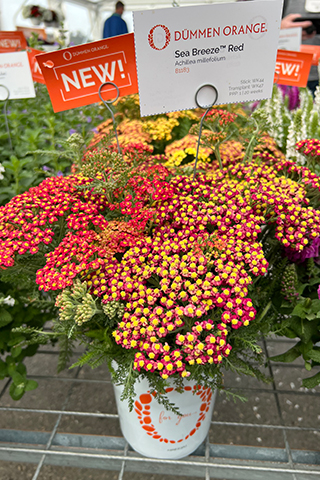
 Achillea Sea Breeze (Dümmen Orange)
Achillea Sea Breeze (Dümmen Orange)
Bred for big, full flowers, while retaining the drought tolerance the genus is known for. Sea Breeze gets Red and Salmon. Zone 3.
Nepeta Serene (Dümmen Orange)
Nepeta Serene White and Lilac are compact, but upright, with excellent drought tolerance. The new sedums are also bred for compactness and the benefits include much safer shipping without the risk of stems snapping, as well as mildew resistance. Zone 3.

 Sedum Cloudburst (Dümmen Orange)
Sedum Cloudburst (Dümmen Orange)
Sedum Cloudburst Burgundy and Green Flash are nice and tidy when young and retain a full, but compact, size in the garden. They’d work great in front of Sedum Autumn Joy, we were told. Zone 4.
Echinacea Mooodz (HilverdaFlorist)
There were five new colors in the Mooodz Echinacea series of first-year flowering varieties from tissue culture, all named for different moods—Serenity (white), Amaze (yellow), Flirty (hot pink), Fearless (orange) and Powerful (deeper, hotter orange). As a reminder, Mooodz are first-year flowering from TC and one of the first echinaceas to flower in the season. Zone 3.
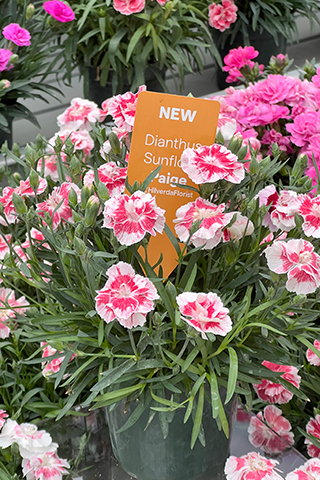
 Dianthus From HilverdaFlorist
Dianthus From HilverdaFlorist
HilverdaFlorist is offering good-looking dianthus in their Beauties (garden) and Sunflor (carnation style) lines, both of which are hardy, compact and floriferous. Beauties gets four new colors and Sunflor gets three. Zone 3.
Digitalis Dottie (ThinkPlants)
Dottie is a five-color perennial series that’s said to be considerably (about 30%) more compact than the Camelot series. Super hardy, Dottie will go as far north as Zone 3.
 Salvia From Jaldety
Salvia From Jaldety
Three interesting salvias from Jaldety—in this case S. microphylla—that the company has been trialing and testing for a couple of years and are now releasing for 2026 are all bicolors with the same airy habit and large flowers. Peach Melba (pictured), Raspberry Melba and Strawberry Melba are Zone 7 to 9 hardy.